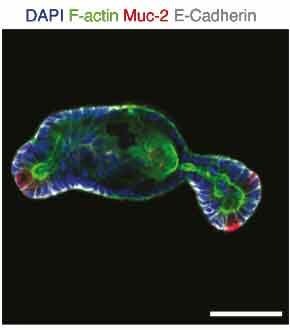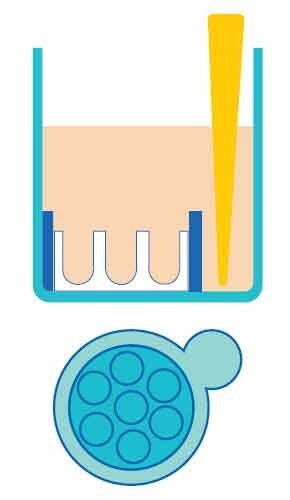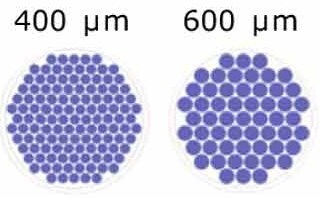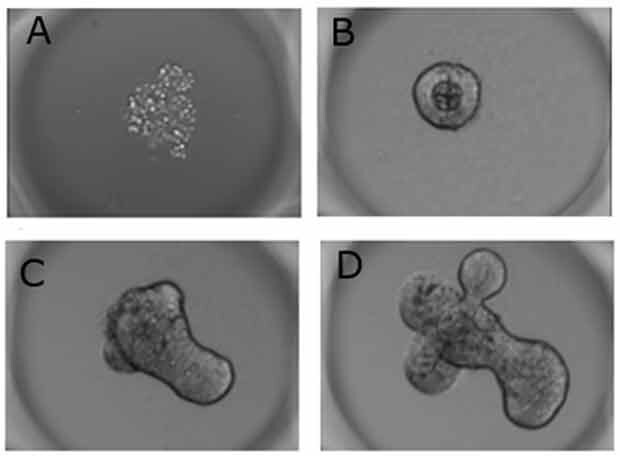Ready-to-Use Plates. Reliable Organoid Formation.
Implement high throughput cell culture projects
with Millicell® Microwell plates
Millicell® Microwell Plates Knowledge Center
3D cell culture is a valuable tool for researchers studying cell interactions, drug discovery and development, immunology, and cancer therapies, among other cellular applications. Selecting the right tool to closely monitor and replicate these in vivo structures can be difficult depending on cell type or application. For more information about our complete 3D cell culture offering, check out our 3D cell culture learning center.

Figure 1.Protein expression of mucin-2 highlighting the presence of Goblet cells in organoids grown in microwell assays; DAPI in blue, F-actin in green, Muc-2 in red, and E-Cadherin in grey.
Millicell® Microwell 96-well plates are a ready-to-use platform containing an array of ultra-dense, U-bottom shaped microwells in a unique polyethylene glycol (PEG) hydrogel solution. The plates enable researchers to perform high throughput and reproducible organoid culture. With multiple microwell sizes to match to different cell lines or applications, Millicell® Microwell plates are ideal for the easy implementation of automation workflows and imaging for 3D cell culture research applications. Here we present answers to your Millicell® Microwell plate questions, such as:
- What are Millicell® Microwell plates?
- How many microwells work for my application?
- How can researchers use Millicell® Microwell plates?
- Which is the ideal 3D culture plate for my application?
Explore detailed information about Millicell® Microwell 96-well plates, frequently asked questions about the plates, and some of the cellular applications that can be performed using the plates. Request more information from our experts.

Figure 2.Schematic of Millicell® Microwell plate wells, showing the pipetting port, O-ring, and microwells.
What are Millicell® Microwell Plates?
Millicell® Microwell 96-well plates are a scalable 3D cell culture system that use an array of microwells to promote homogeneous single organoid formation for high throughput and screening applications. Because each well in the plate contains 55-121 microwells, organoid and spheroid formation can be scaled up in the thousands. Millicell® Microwell plates also adhere to SBS standard plate format to fit automation workflows.
Millicell® Microwell plates contain a unique, low-attachment PEG hydrogel-based microwells, so no solid extracellular matrix is required. The PEG solution is biocompatible, cell-repellent and water-based, so it allows diffraction-less imaging and for efficient cell aggregation into microtissues in suspension-like conditions at the bottom of the microcavities.
The meniscus breaking design ensures homogeneous seeding of cells in the microwells. This technology leads to single organoid formation in each microwell. The microwells have an extreme aspect ratio of 1:1.2, ensuring that the organoids stay within the individual microwells. Through our protocol for cell seeding using Millicell® Microwell plates, we demonstrate how to seed cells without disturbing the hydrogel microwells.
The spheroids and organoids generated in Millicell® Microwell plates form in a single focal plane, which standardizes high throughput imaging applications. Importantly, to avoid disturbing the organoids in the microwells, Millicell® Microwell plates contain an independent pipetting port for safe media exchange and liquid handling.
Choosing a Millicell® Microwell Plate
We offer Millicell® Microwell 96-well plates in multiple formats with several different microwell diameters. These different diameters can help users accommodate the different sizes that organoids can reach. For example, organoids that develop from a low number of cells or for a short time may benefit from a smaller microwell diameter and higher microwell density per area, as this would lead to more datapoints per well. Organoids that need a long maturation time and grow bigger in size are better cultured in bigger microwell diameters.
Our collection of Millicell® Microwell 96-well Plates includes: |
|---|

Figure 3.Schematic of the number of microwells per diameter in Millicell® Microwell plates.
Millicell® Microwell Plate Applications
Promising models for cancer research, personalized medicine, and drug development, traditional organoid culture often involve an external, solidified extracellular matrix (ECM), which is not always reproducible. Millicell® Microwell plates have a PEG hydrogel within the microwells, promoting reliable, homogeneous organoid generation in one focal plane and streamlining organoid formation and analysis. Want to learn more about Millicell® Microwell plates in action? Check out our recent technical articles showing just some of the many applications the plates are ideal for.
Related Technical Content

Figure 4.Brightfield images of mouse intestinal organoids on A) hour 1, B) 2 days, C) 3 days, and D) 4 days after seeding on Millicell® Microwell plates.
FREQUENTLY ASKED QUESTIONS ABOUT Millicell® MICROWELL PLATES
Have questions about using Millicell® Microwell plates? Need to know how to perform immunostaining or cyrosectioning directly on the plate? Our team of scientists have answered your frequently asked questions about Millicell® Microwell plates and how to use them in your 3D cell culture applications.
View our Millicell® Microwell Plates Frequently Asked Questions (FAQs)
Per continuare a leggere, autenticati o crea un account.
Non hai un Account?